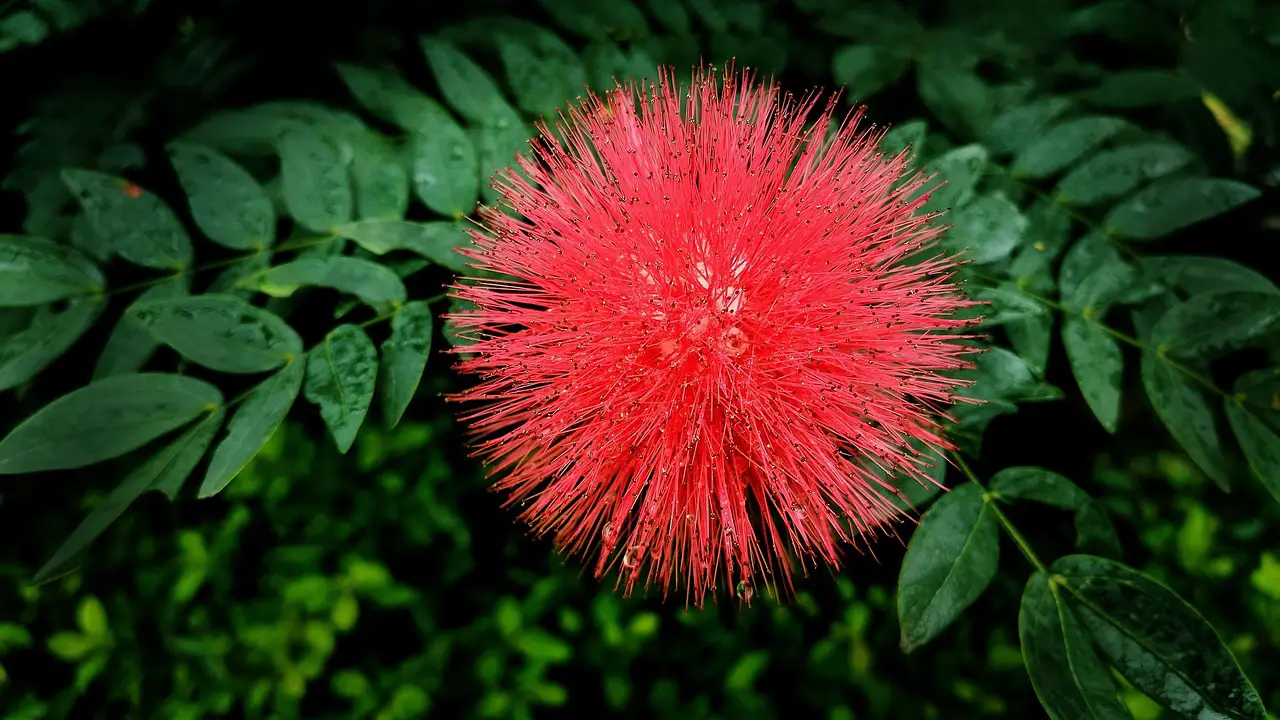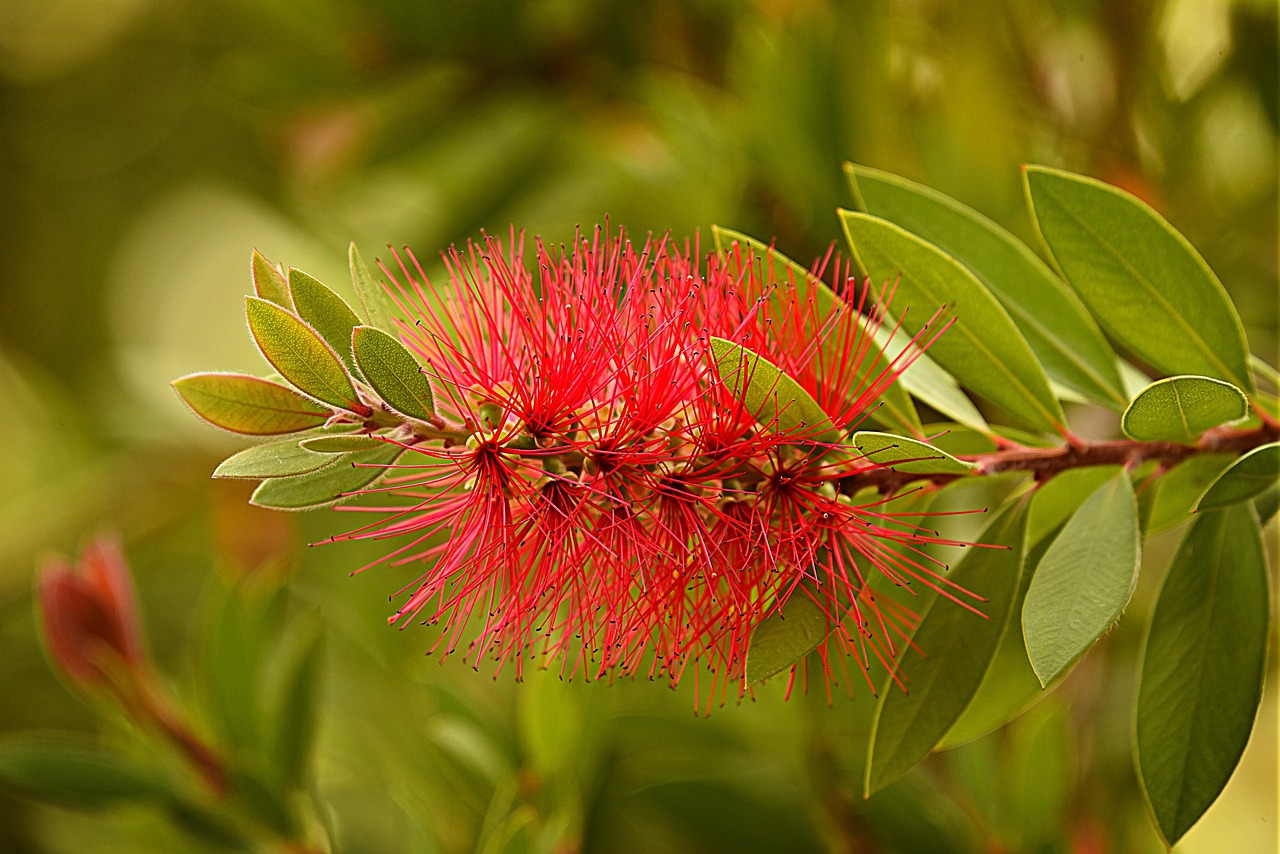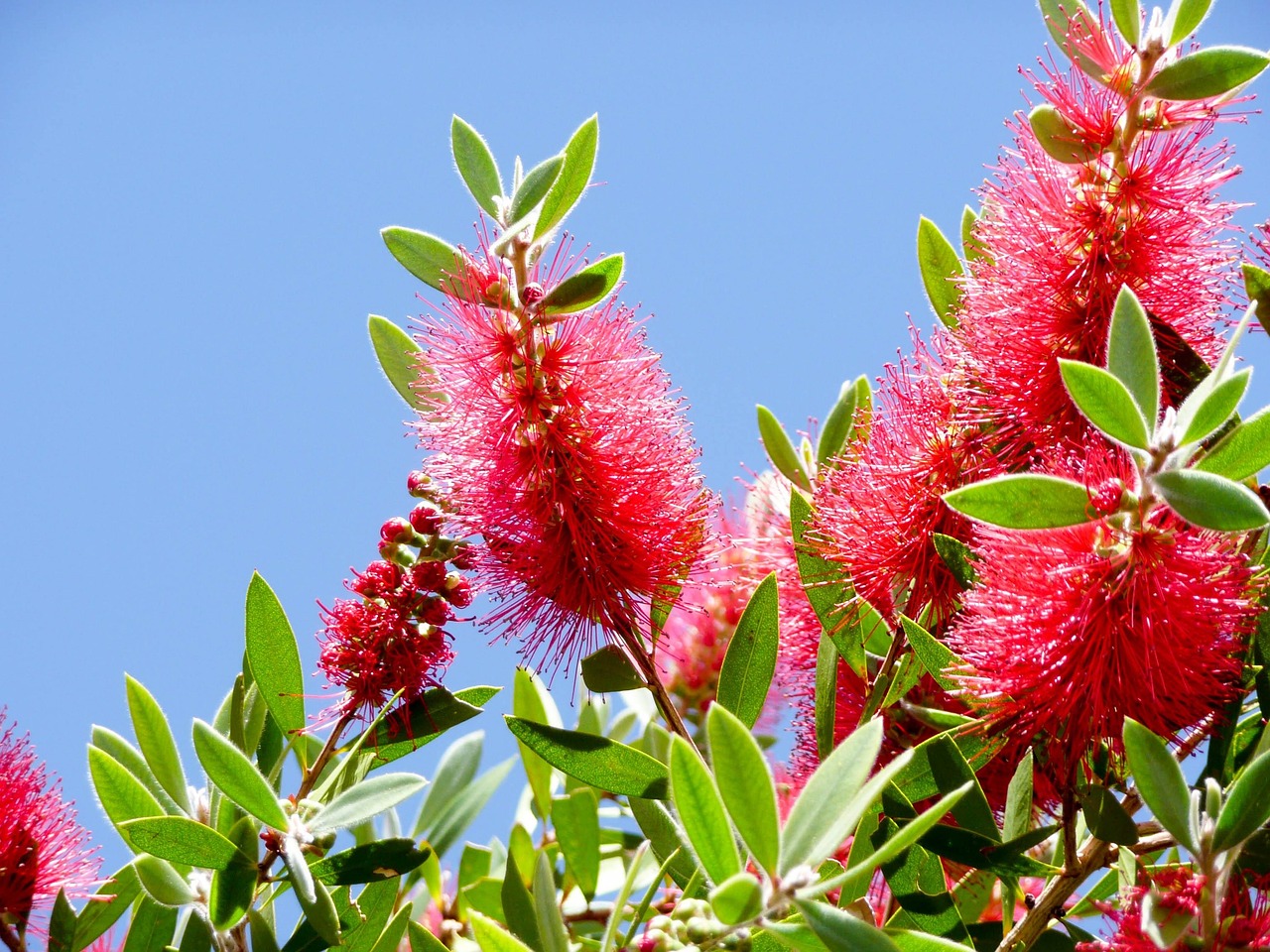The Bottlebrush tree (Callistemon) exhibits a moderate growth rate, reaching heights of 10 to 30 feet depending on the species. Flowering typically occurs in spring and summer, showcasing vibrant red, pink, or yellow blooms that attract pollinators.
The Bottlebrush tree is a popular ornamental plant known for its unique, brush-like flowers resembling traditional bottle brushes. Native to Australia, these trees have adapted well to various climates and soils, making them a favored choice for gardens and landscapes around the world. Their stunning flowers not only add aesthetic value but also play a crucial role in attracting bees, birds, and other pollinators.

Understanding the growth rate and flowering patterns of the Bottlebrush tree is essential for gardeners and horticulturists aiming to cultivate this beautiful species. The growth rate can vary significantly based on factors such as species type, environmental conditions, and care practices. Similarly, flowering can be influenced by weather patterns and cultural practices.
Growth Rate of Bottlebrush Trees
Bottlebrush trees generally display a moderate growth rate, which can be categorized based on the specific species. On average, these trees can grow anywhere from 1 to 3 feet per year under optimal conditions. Factors such as soil quality, sunlight exposure, and water availability greatly influence their growth.
- Species Variation: Different species of Bottlebrush trees exhibit varied growth rates. For instance, the Callistemon citrinus tends to grow faster than Callistemon viminalis.
- Environmental Factors: Adequate sunlight and well-drained soil are essential for promoting healthy growth.
- Watering Needs: Regular watering during dry spells supports rapid growth, especially in young trees.
In addition to these factors, proper pruning can encourage bushier growth and enhance flowering. Pruning should be done after flowering to avoid cutting off potential blooms for the next season. This practice helps maintain the shape and health of the tree while promoting new growth.

Flowering Patterns
The flowering patterns of the Bottlebrush tree are one of its most striking features. Typically, these trees bloom in late spring through summer. However, some species may exhibit a longer or shorter flowering period depending on climatic conditions and care practices.
The flowers of the Bottlebrush tree are known for their bright colors and distinctive shape. They consist of numerous long stamens that extend from the flower head, creating a brush-like appearance. This unique structure not only adds visual interest but also serves a functional purpose by attracting a variety of pollinators.
Here is an overview of flowering characteristics by species:

| Species | Flower Color | Bloom Time |
|---|---|---|
| Callistemon citrinus | Red | Spring to Summer |
| Callistemon viminalis | Pink | Late Spring to Early Summer |
| Callistemon pallidus | Yellow | Summer |
The vibrant flowers not only enhance the beauty of landscapes but also provide essential nectar for bees and other beneficial insects. This ecological interaction is vital for promoting biodiversity in gardens and natural habitats alike.
In summary, the Bottlebrush tree’s growth rate and flowering patterns are influenced by various factors, including species type, environmental conditions, and care methods. Understanding these aspects can lead to healthier trees and more abundant blooms, contributing to the overall beauty of any garden setting.
Factors Influencing Growth and Flowering
The growth rate and flowering patterns of the Bottlebrush tree can be significantly influenced by several factors. These elements include environmental conditions, soil quality, water availability, and maintenance practices. Understanding these factors can help gardeners optimize the growth and flowering of their Bottlebrush trees.
Environmental Conditions
Environmental factors play a crucial role in the health and development of Bottlebrush trees. Key elements include:

- Sunlight: Bottlebrush trees thrive in full sun. They require at least six hours of direct sunlight each day to promote healthy growth and abundant flowering.
- Temperature: These trees prefer warm climates but can tolerate some variations. They generally do well in USDA zones 8 to 11.
- Humidity: While Bottlebrush trees can adapt to different humidity levels, they flourish in moderate to high humidity, which helps in flower production.
Soil Quality
The quality of soil is another critical factor affecting the growth of Bottlebrush trees. These trees prefer:
- Well-drained Soil: Good drainage is vital as Bottlebrush trees are susceptible to root rot if waterlogged.
- Sandy or Loamy Soil: A mix of sandy and loamy soil is ideal for Bottlebrush trees, providing both drainage and nutrients.
- pH Levels: Bottlebrush trees thrive in slightly acidic to neutral soil with a pH range of 6.0 to 7.0.
Watering Practices
Watering is essential for the growth and flowering of Bottlebrush trees. Here are some guidelines:
- Young Trees: Newly planted Bottlebrush trees require regular watering until they establish roots. This may mean watering once or twice a week during dry periods.
- Mature Trees: Once established, these trees are relatively drought-tolerant but benefit from deep watering during prolonged dry spells.
- Avoid Overwatering: To prevent root rot, ensure that the soil dries out somewhat between watering sessions.
Pruning for Healthy Growth
Pruning is an essential maintenance practice that can significantly impact the health and flowering of Bottlebrush trees. Proper pruning techniques enhance growth and shape while encouraging more blooms.
When to Prune
The best time to prune Bottlebrush trees is after their flowering season. This timing allows for the removal of spent flowers and encourages new growth and flowering for the next season.
Pruning Techniques
- Remove Dead or Damaged Wood: Start by cutting away any dead or damaged branches to promote healthy growth.
- Thin Out Crowded Areas: If the tree has a dense canopy, selectively remove some branches to improve air circulation and light penetration.
- Shape the Tree: Lightly shape the tree to maintain its desired form while avoiding excessive cutting, which may shock the plant.
Pest and Disease Management
Like many plants, Bottlebrush trees can be susceptible to pests and diseases that may affect their growth and flowering. Keeping an eye on potential issues can help maintain their health.
Common Pests
- Aphids: These small insects can cluster on new growth, sucking sap from the plant. Regular inspection and natural predators can help keep them in check.
- Scale Insects: Scale insects attach themselves to branches and leaves, causing damage by feeding on sap. Insecticidal soap can be effective against these pests.
- Spider Mites: High temperatures and low humidity can lead to spider mite infestations. Regular watering and maintaining humidity levels can help prevent these pests.
Disease Issues
Bottlebrush trees may also face disease challenges, such as:
- Root Rot: Often caused by poor drainage, root rot can lead to tree decline. Ensure proper watering practices to avoid this issue.
- Leaf Spot: Fungal infections may manifest as spots on leaves. Pruning affected leaves and improving air circulation can help manage this problem.
By understanding these various factors influencing growth and flowering, gardeners can take proactive steps in caring for their Bottlebrush trees. This leads to healthier plants that not only thrive but also produce beautiful blooms year after year.
Ideal Growing Conditions for Bottlebrush Trees
To achieve optimal growth and vibrant flowering in Bottlebrush trees, it is essential to provide the right growing conditions. Understanding the tree’s natural habitat can help replicate these conditions in a garden or landscape setting.
Sunlight Requirements
Bottlebrush trees flourish in full sunlight. Here are key points regarding their sunlight needs:
- Minimum Sunlight: They require at least six hours of direct sunlight daily for healthy growth and flowering.
- Shade Tolerance: While Bottlebrush trees can tolerate some shade, excessive shade can lead to sparse flowering and weak growth.
Soil Conditions
As previously mentioned, soil quality is vital for the health of Bottlebrush trees. Here are some considerations regarding soil:
- Soil Texture: A mix of sandy and loamy soil is ideal for good drainage and nutrient retention.
- Organic Matter: Incorporating organic materials, such as compost, can enhance soil fertility and improve moisture retention.
- Drainage: Ensure that the planting area allows for adequate drainage to prevent root rot and other moisture-related issues.
Watering Practices
Proper watering is essential to support the growth and flowering of Bottlebrush trees. Here are some effective practices:
- Deep Watering: Water deeply but infrequently to encourage deep root growth. This method helps the tree become more drought-resistant.
- Seasonal Adjustments: Adjust watering frequency based on seasonal changes. More frequent watering may be necessary during hot, dry periods.
- Mulching: Applying a layer of mulch around the tree can help retain soil moisture and regulate temperature.
Fertilization Strategies
Fertilizing Bottlebrush trees appropriately can enhance their growth rate and flowering potential. Here are some tips for effective fertilization:
Types of Fertilizers
- Slow-Release Fertilizers: Using a slow-release fertilizer formulated for flowering plants provides steady nutrients over time.
- Organic Options: Organic fertilizers, such as compost or well-rotted manure, can improve soil health and provide essential nutrients.
- Citrus Fertilizers: Fertilizers designed for citrus trees can also be beneficial, as they often contain the necessary micronutrients that Bottlebrush trees require.
Fertilization Schedule
A proper fertilization schedule is crucial for maximizing tree health. Consider the following guidelines:
- Spring Application: Apply fertilizer in early spring before new growth begins to support the growing season.
- Mid-Season Boost: A second application during mid-summer can further enhance growth and flowering, especially if the tree shows signs of nutrient deficiency.
- Avoid Over-Fertilization: Too much fertilizer can harm the tree. Always follow package instructions and monitor tree health.
Additions to Enhance Growth
Certain practices can further support the growth and flowering of Bottlebrush trees. Implementing these strategies may lead to healthier plants and more vibrant blooms.
Companion Planting
Companion planting involves growing different plants together to benefit each other. Suitable companions for Bottlebrush trees include:
- Nitrogen-Fixing Plants: Plants like clover can enrich the soil with nitrogen, benefiting nearby Bottlebrush trees.
- Pollinator-Friendly Flowers: Adding flowers that attract pollinators, such as lavender or salvia, can enhance the overall health of the ecosystem around the Bottlebrush tree.
Pest Prevention Measures
Proactive measures can help prevent pest infestations that may hinder growth and flowering:
- Natural Predators: Encourage beneficial insects like ladybugs and lacewings that prey on aphids and other pests.
- Regular Inspections: Routinely check for signs of pests or diseases. Early detection can make management easier.
- Healthy Practices: Maintain good cultural practices like proper spacing and air circulation to reduce pest problems.
By creating ideal growing conditions, utilizing appropriate fertilization strategies, and adopting preventive measures, gardeners can cultivate thriving Bottlebrush trees that showcase stunning flowers while also contributing positively to their local ecosystems.
Additional Benefits of Bottlebrush Trees
Beyond their aesthetic appeal, Bottlebrush trees offer various ecological and practical benefits. Understanding these advantages can further encourage gardeners to incorporate them into their landscapes.
Ecological Contributions
Bottlebrush trees play a significant role in supporting local ecosystems. Key contributions include:
- Attracting Pollinators: The vibrant flowers of Bottlebrush trees are rich in nectar, making them a favorite among bees, butterflies, and hummingbirds. This attraction supports pollination for not only the Bottlebrush but also nearby plants.
- Habitat Creation: These trees provide shelter and nesting sites for various bird species. Their dense foliage can offer protection from predators and harsh weather conditions.
- Soil Improvement: The leaf litter from Bottlebrush trees can enhance soil quality by adding organic matter as it decomposes, benefiting surrounding plants.
Cultural Significance
In addition to ecological benefits, Bottlebrush trees hold cultural significance in many regions:
- Native Australian Heritage: As native Australian plants, they are integral to the cultural identity and heritage of Indigenous Australian communities.
- Gardening Trends: Their unique appearance has made them popular in landscape design, contributing to trends that emphasize native and drought-tolerant gardening.
Uses in Landscaping
Bottlebrush trees are versatile in landscaping applications. Some common uses include:
- Screening and Privacy: Their dense growth makes Bottlebrush trees effective for creating privacy screens or windbreaks.
- Specimen Trees: Due to their striking flowers and unique form, they can serve as focal points in gardens or parks.
- Low Maintenance Options: Once established, Bottlebrush trees require minimal maintenance, making them suitable for busy gardeners or low-maintenance landscapes.
Final Thoughts
The Bottlebrush tree is a remarkable plant that offers both beauty and functionality in various landscapes. With its moderate growth rate and stunning flowering patterns, it serves as an attractive addition to gardens while also providing vital ecological benefits. Understanding the specific needs of this tree regarding sunlight, soil, watering, and pest management can lead to successful cultivation.
As we have explored, the inclusion of Bottlebrush trees not only enhances the visual appeal of outdoor spaces but also promotes biodiversity by attracting pollinators and providing habitat for wildlife. Their cultural significance and versatility make them a valuable choice for gardeners looking to create sustainable and aesthetically pleasing environments.
In conclusion, whether you are an experienced gardener or a novice looking to enhance your landscape, considering the Bottlebrush tree can yield substantial rewards. By following best practices for growth and maintenance, you can enjoy the vibrant blooms and ecological benefits that these remarkable trees offer for years to come.
